After you have finished setting up both POS and QuickBooks Online, you can begin to import information into your QuickBooks company. Your accounting information will be stored, in your oil directory or the directory you have set up in your Set Up Communications Controls (3-2) menu, every night during your closing. This article gives you instructions on how to import this information from your POS system into QuickBooks Online.
| Note: | For reference purposes, all of the commands used to maintain and retrieve data are explained in detail in the Glossary of Linux Command Terms for Maintaining and Clearing .csv Files section below. |
Refer to the following steps to help you retrieve and clear the QuickBooks Online (.csv) files in your oil directory:
| Note: | If you have a directory other than the oil directory set up in Set Up Communications Controls, then substitute that directory name in place of oil in the commands below. |
ls *.csv ¦less (make sure to leave one space between ls and *) (The character between .csv and less is called a pipe and can usually be found near the Backspace key on your keyboard.)
You see files that look like the following:
g00001c3.csv
r00001e3.csv
v00001e3.csv
| Note: | Refer to the File Naming Conventions section below for a detailed description of what the characters in these file names represent. |
| To | Do |
|---|---|
| Place a Linux file on a DOS formatted disk. | Put a blank, DOS formatted disk, that has not been write protected, into the disk drive and type the following command:
mcopy g00001c3.csv a:
|
| Remove a file from the directory. | Type the following command:
rm -i v00001c3.csv
|
| Note: | Read the documentation included with QuickBooks Online to determine how you can use this information to manage your accounts. |
Use the following steps to import general ledger (g) or inventory activity (v) files into QuickBooks Online:
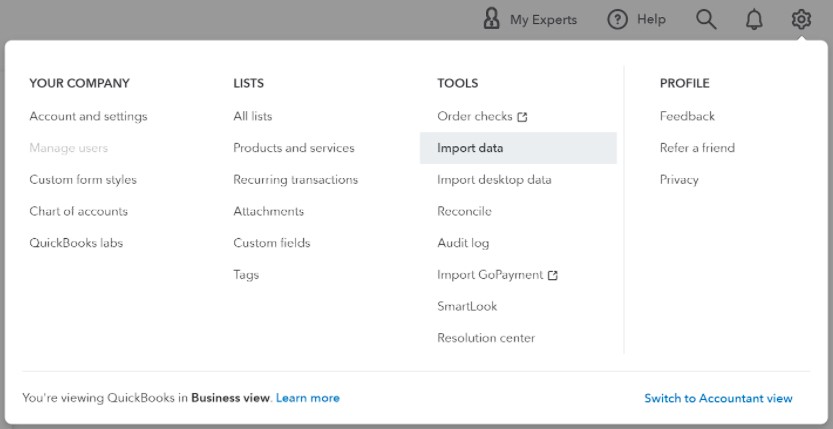

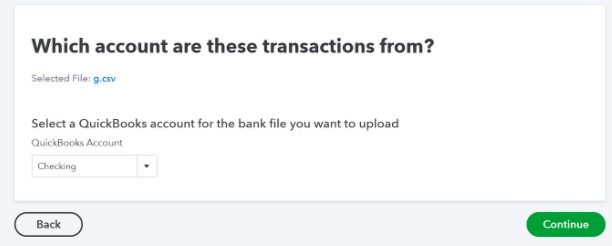
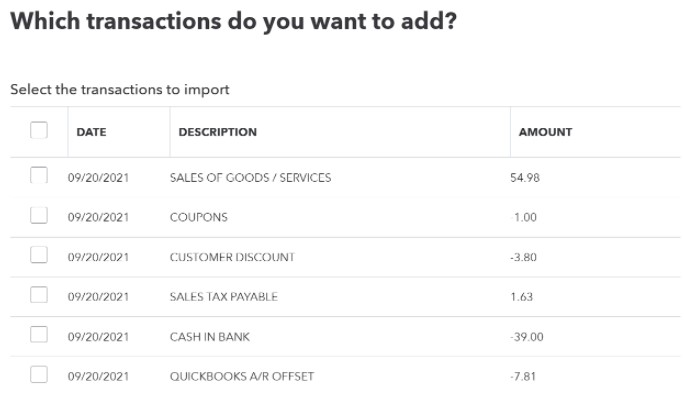
| Note: | QuickBooks Online users in the U.S. need to have taxes disabled in order to import R files.
|
For more information on importing invoices, see Intuit’s QuickBooksHelp. Use the following steps to import accounts receivable (r) files into QuickBooks Online:


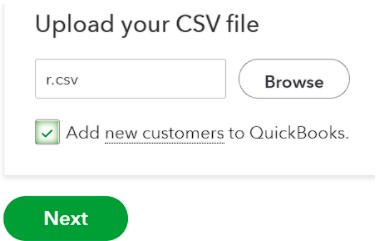
| Note: | We recommend selecting the option Add new customers to QuickBooks. |
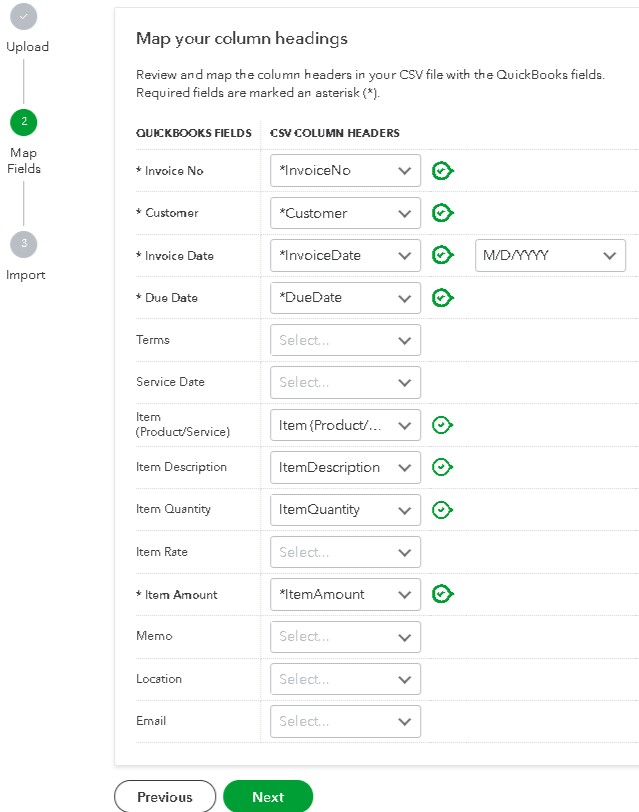
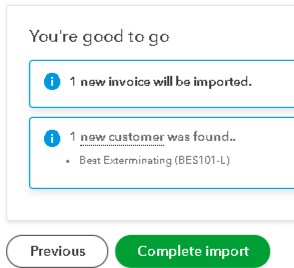
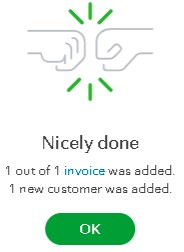
The following table explains the naming conventions of the files that you will be importing. All QuickBooks Online files end with the extension .csv. The following is an example of a QuickBooks Online file.
x#####md.csv
| Field | Definition | |||||||||||||||||||||||||||||||||||
|---|---|---|---|---|---|---|---|---|---|---|---|---|---|---|---|---|---|---|---|---|---|---|---|---|---|---|---|---|---|---|---|---|---|---|---|---|
| ##### | Store Number | |||||||||||||||||||||||||||||||||||
| x | This character denotes the file type. There are three different types:
|
|||||||||||||||||||||||||||||||||||
| m | This character denotes the month. It is always a lowercase letter, ranging from a to l as follows:
|
|||||||||||||||||||||||||||||||||||
| d | This character denotes the day. The characters range from a to z and 1 to 5 and are as follows:
|
You will need the commands below to gather and clear information on your Linux POS system.
 |
Be careful how you use this information. We are giving you these commands so that you can have greater flexibility and create customized reports. Be aware that if you use these commands incorrectly, you can do serious damage to your system data. |
cd
Command used for changing the current directory.
pwd
Linux command to determine present working (current) directory.
rm -i
Linux command to delete a file.
ls
Linux command to list all files on the current directory.
¦less
Linux command used with command ls to limit the list of files to one page of information at a time. The space bar is pressed for more pages.
mcopy filename a:
Linux command used to put a file onto a DOS formatted disk.
The QuickBooks Accounts Receivable information is taken from your invoicing and vehicle files and shows individual fleet charge transactions. These files contain comma-separated values (CSV). The first line lists the column headers and each subsequent line contains transaction details.
“*InvoiceNo”,”*Customer”,”*InvoiceDate”,”*DueDate”,”Item (Product/Service)”,”ItemDescription”,”ItemQuantity”,”*ItemAmount”,”*ItemTaxCode”,”Location”,
“21091300004570-01906″,”DONLEN FLEET (DONLEN-N)”,”09/13/2021″,”09/13/2021″,”Job”,”FULL SERVICE OIL CHANGE”,1,28.99,”Out of Scope”,”Store 01906″,
“21091300004570-01906″,,,,”Part”,”WPH59 OIL FILTER”,1,0,”Out of Scope”,”Store 01906″,
“21091300004570-01906″,,,,”Lubricant”,”ISI CONV SAE 5W30″,7.5,5,”Out of Scope”,”Store 01906″,
“21091300004570-01906″,,,,”Other”,”API SN ILSAC GF5″,1,0,”Out of Scope”,”Store 01906″,
“21091300004570-01906″,,,,”Other”,”Shop Supplies”,1,2.5,”Out of Scope”,”Store 01906″,
“21091300004570-01906″,,,,”Tax1″,”SALES TAX”,1,1.17,”Out of Scope”,”Store 01906″,
“21091400009859-01906″,”Best Exterminating (BES101-L)”,”09/14/2021″,”09/14/2021″,”Job”,”FULL SERVICE OIL CHANGE”,1,38.99,”Out of Scope”,”Store 01906″,
“21091400009859-01906″,,,,”Part”,”WPH400 OIL FILTER”,1,0,”Out of Scope”,”Store 01906″,
“21091400009859-01906″,,,,”Lubricant”,”ISI CONV SAE 5W30″,5.5,2,”Out of Scope”,”Store 01906″,
“21091400009859-01906″,,,,”Job”,”TIRE INSPECTION”,1,0,”Out of Scope”,”Store 01906″,
“21091400009859-01906″,,,,”Discount”,”SENIOR DISOUNT 10%”,1,-3.9,”Out of Scope”,”Store 01906″,
“21091400009859-01906″,,,,”Tax1″,”SALES TAX”,1,0,”Out of Scope”,”Store 01906″,
| 1 | 2 | 3 | 4 | 5 | 6 | 7 | 8 | 9 | 10 |
|---|---|---|---|---|---|---|---|---|---|
| InvoiceNo | Customer | InvoiceDate | DueDate | Item (Product/Service) | ItemDescription | ItemQuantity | ItemAmount | ItemTaxCode | Location |
| Num. | Description | Definition | ISI Field Name | Output Format* | Quoted? | Example Value | Version When Added |
|---|---|---|---|---|---|---|---|
| 1 | InvoiceNo | The 14-digit transaction number and 5-digit store number, separated by a dash. | #(14)-#(5) | X | 21091400009859-01906 | 15.28 | |
| 2 | Customer | Fleet name and fleet ID. This is only listed with the first line item of the invoice. | inarf1.name
inarf1.cust inarf1.type |
X(30) (X(10)-X(1)) | X | Best Exterminating (BES101-L) | 15.28 |
| 3 | InvoiceDate | The date the invoice was created. This is only listed with the first line item of the invoice. | inf1.date | ##/##/#### | X | 09/14/2021 | 15.28 |
| 4 | DueDate | The date invoice payment is due. This may be the same as the InvoiceDate. This is only listed with the first line item of the invoice. | ##/##/#### | X | 09/14/2021 | 15.28 | |
| 5 | Item (Product/Service) | The type of item: Coupon Discount Job Lubricant Other Part Tax# |
X(9) | X | Job | 15.28 | |
| 6 | ItemDescription | The description of the line item. | inf1a.desc | X(30) | X | FULL SERVICE OIL CHANGE | 15.28 |
| 7 | ItemQuantity | The quantity of the line item. | inf1a.qty | #(4.2) | 1 | 15.28 | |
| 8 | ItemAmount | The dollar amount due for a line item or the amount charged for a tax or the amount subtracted for a coupon or discount. | inf1a.amount | #(4.2) | 38.99 | 15.28 | |
| 9 | ItemTaxCode | X | Out of Scope | 15.28 | |||
| 10 | Location | The 5-digit store number where the activity was generated. | info.store_nbr | #(5) | X | Store 01906 | 15.28 |
*The Output Format column uses X to represent string fields and # to represent numeric fields. For example, X(5) represents a string up to five characters in length and #(14) represents a number up to 14 digits in length.
The QuickBooks General Ledger information is taken from your invoicing and inventory files and shows amounts for sales, warranties, taxes, coupons and discounts, till shortages, and paid ins/outs. These files contain comma-separated values (CSV). The first line lists the column headers and each subsequent line contains an account balance value.
Date,Description,Amount
09/14/2021,”SALES OF GOODS / SERVICES”,103.97,
09/14/2021,”CUSTOMER DISCOUNT”,-7.05,
09/14/2021,”COUPONS”,-2,
09/14/2021,”SALES TAX PAYABLE”,1.28,
09/14/2021,”CASH OVER OR SHORT”,42.85,
09/14/2021,”CASH IN BANK”,-42.85,
09/14/2021,”QUICKBOOKS A/R OFFSET”,-96.7,
09/14/2021,”WARRANTY”,-2,
| Num. | Description | Definition | ISI Field Name | Output Format* | Quoted? | Example Value | Version When Added |
|---|---|---|---|---|---|---|---|
| 1 | Date | The date of the transaction. | inf0.today | ##/##/#### | 09/14/2021 | ||
| 2 | Description | The account description. | inglc.title | X(30) | X | SALES OF GOODS / SERVICES | |
| 3 | Amount | The dollar amount of the change to the account. | #(4.2) | 103.97 |
*The Output Format column uses X to represent string fields and # to represent numeric fields. For example, X(5) represents a string up to five characters in length and #(14) represents a number up to 14 digits in length.